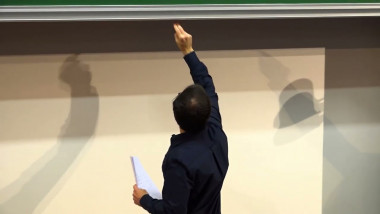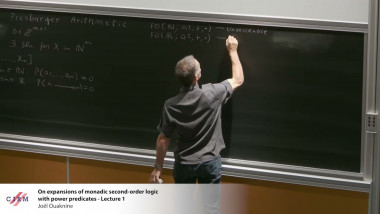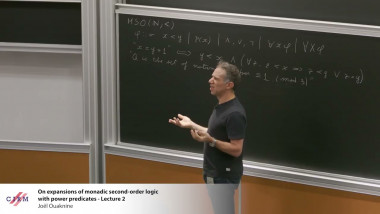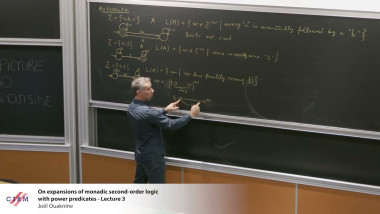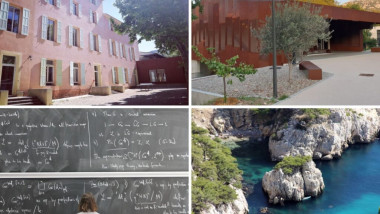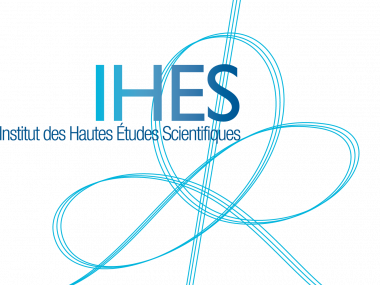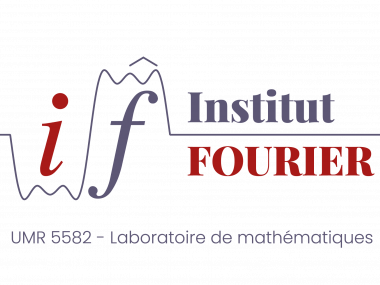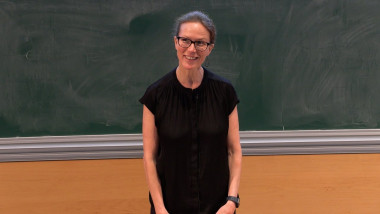Apparaît dans la collection : Jean-Morlet Chair - Doctoral school : Frobenius distribution on curves / Chaire Jean-Morlet - Ecole doctorale : distribution de Frobenius sur des courbes
In the 1970s, S. Lang and H. Trotter developed a probabilistic model which led them to their conjectures on distributional aspects of Frobenius in $GL_2$-extensions. These conjectures, which are still open, have been a significant source of stimulation for modern research in arithmetic geometry. The present lectures will provide a detailed exposition of the Lang-Trotter conjectures, as well as a partial survey of some known results.
Various questions in number theory may be viewed in probabilistic terms. For instance, consider the prime number theorem, which states that, as $x\rightarrow \infty$ , one has
$#\left \{ primes\, p\leq x \right }\sim \frac{x}{\log x}$
This may be seen as saying that the heuristic "probability" that a number $p$ is prime is about $1/\log p$. This viewpoint immediately predicts the correct order of magnitude for the twin prime conjecture. Indeed, if $p$ and $p+2$ are seen as two randomly chosen numbers of size around $t$, then the probability that they are both prime should be about $1/(\log t)^2$, which predicts that
$#\left \{ primes\, p\leq x : p+2\, is\, also\, prime \right }\asymp \int_{2}^{x}\frac{1}{(\log t)^2}dt \sim \frac{x}{\log x}$
In this naive heuristic, the events "$p$ is prime" and "$p+2$ is prime" have been treated as independent, which they are not (for instance their reductions modulo 2 are certainly not independent). Using more careful probabilistic reasoning, one can correct this and arrive at the precise conjecture
$#\left \{ primes\, p\leq x : p+2\, is\, also\, prime \right } \sim C_{twin}\frac{x}{(\log x)^2}$,
where $C_{twin}$ is the constant of Hardy-Littlewood.
In these lectures, we will use probabilistic considerations to study statistics of data attached to elliptic curves. Specifically, fix an elliptic curve $E$ over $\mathbb{Q}$ of conductor $N_E$. For a prime $p$ of good reduction, theFrobenius trace $a_p(E)$ and Weil $p$-root $\pi _p(E)\in \mathbb{C}$ satisfy the relations
$#E(\mathbb{F}_p)=p+1-a_p(E)$,
$X^2-a_p(E)X+p=(X-\pi _p(E))(X-\overline{ \pi _p(E)})$.
Because of their connection via the Birch and Swinnerton-Dyer conjecture to ranks of elliptic curves (amongother reasons), there is general interest in understanding the statistical variation of the numbers $a_p(E)$ and $\pi_p(E)$, as $p$ varies over primes of good reduction for E. In their 1976 monograph, Lang and Trotter considered the following two fundamental counting functions:
$\pi_{E,r}(x) :=#\left \{ primes: p\leq x:p \nmid N_E, a_p(E)=r \right }$
$\pi_{E,K}(x) :=#\left \{ primes: p\leq x:p \nmid N_E, \mathbb{Q}(\pi_p(E))=K \right }$,
where $ r \in \mathbb{Z}$ is a fixed integer, $K$ is a fixed imaginary quadratic field. We will discuss their probabilistic model, which incorporates both the Chebotarev theorem for the division fields of $E$ and the Sato-Tatedistribution, leading to the precise (conjectural) asymptotic formulas
(1) $\pi_{E,r}(x)\sim C_{E,r}\frac{\sqrt{x}}{\log x}$
$\pi_{E,K}(x)\sim C_{E,K}\frac{\sqrt{x}}{\log x}$,
with explicit constants$C_{E,r}\geq 0$ and $C_{E,K} > 0$. We will also discuss heuristics leading to the conjectureof Koblitz on the primality of $#E( \mathbb{F}_p)$, and of Jones, which combines these with the model of Lang-Trotter for $\pi_{E,r}(x)$ in order to count amicable pairs and aliquot cycles for elliptic curves as introduced by Silvermanand Stange.
The above-mentioned conjectures are all open, although (in addition to the bounds mentioned in the previous section) there are various average results which give evidence of their validity. For instance, let $R\geq 1$ and $S\geq 1$be an arbitrary positive length andwidth, respectively, and define
$\mathcal{F}(R,S):= \{ E_{r,s}:(r,s)\in \mathbb{Z}^2,-16(4r^3+27s^2)\neq 0, \left | r \right |\leq R: $ and $\left | s \right | \leq S }$,
where $E_{r,s}$ denotes the curve with equation $y^2=x^3+rx=s$. The work of Fouvry and Murty $(r=0)$, and of David and Pappalardi $(r\neq 0)$, shows that, provided min $\left \{ R(x), S(x) \right }\geq x^{1+\varepsilon }$, one has
(2) $\frac{1}{\left |\mathcal{F}(R(x),S(x)) \right |} \sum_{E\in \mathcal{F}(R(x),S(x))} \pi_{E,r}(x) \sim C_r \frac{\sqrt{x}}{\log x}$
where $C_r$ is a constant. We will survey this and other theorems on average, and then discuss the nature of the associated constants $C_{E,r},C_{E,K}$ etc. We will discuss the statistical variation of these constants as $E$ varies over all elliptic curves over $\mathbb{Q}$, and use this to confirm the consistency of (2) with (1), on the level of the constants
Keywords : Galois representation - elliptic curve - trace of Frobenius - Chebotarev density theorem - Sato-Tate conjecture - Lang-Trotter conjecture
